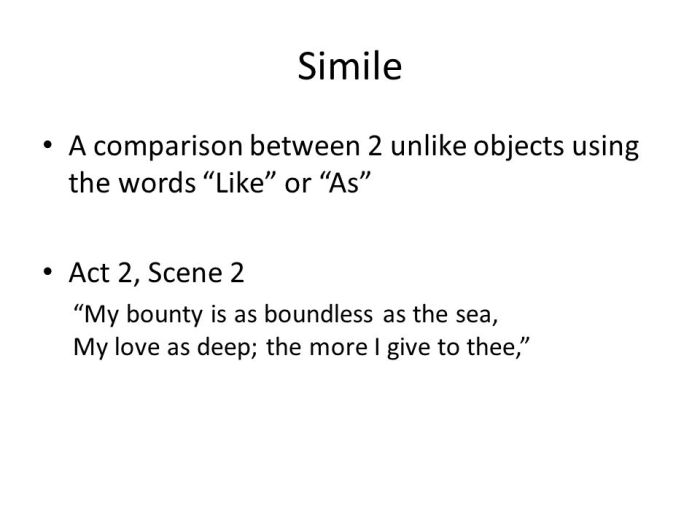Similes in romeo and juliet – Embarking on a literary expedition into William Shakespeare’s timeless masterpiece, Romeo and Juliet, we delve into the captivating realm of similes, unveiling their profound impact on characterization, setting, and the play’s overarching themes.
These vivid comparisons, woven into the fabric of the text, illuminate the complexities of Romeo and Juliet’s personalities, paint a vivid tapestry of their surroundings, and resonate deeply with the play’s central messages of love, conflict, and destiny.
Similes in Romeo and Juliet
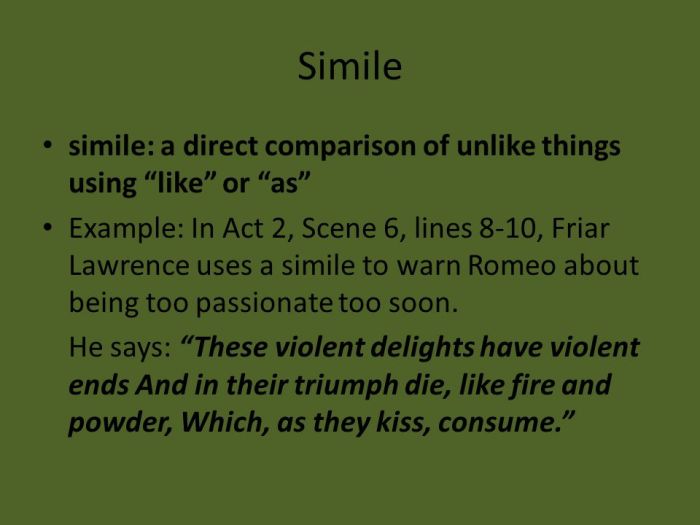
Similes are a literary device that compares two things using “like” or “as.” They are used to create vivid imagery and to help the reader understand the characters and themes of a story.In Romeo and Juliet, Shakespeare uses similes extensively to create a rich and poetic tapestry.
For example, he compares Romeo’s love for Juliet to “a lightning flash” and Juliet’s beauty to “the morning sun.” These similes help the reader to visualize the intensity of Romeo’s love and the radiant beauty of Juliet.Similes also play an important role in developing the characters of Romeo and Juliet.
For example, Romeo’s use of similes reveals his passionate and romantic nature, while Juliet’s use of similes reveals her innocence and vulnerability.
Significance of Similes in Romeo and Juliet
The similes in Romeo and Juliet serve a number of important functions. First, they help to create a vivid and memorable picture of the characters and their world. Second, they help to develop the characters and to reveal their inner thoughts and feelings.
Third, they help to create a sense of atmosphere and to set the tone of the play.Overall, the similes in Romeo and Juliet are a powerful literary device that helps to create a rich and meaningful experience for the reader.
Similes and Characterization
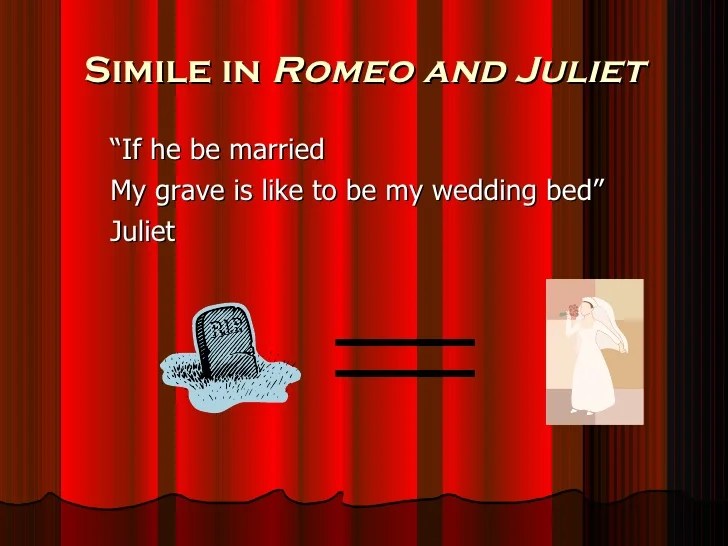
Similes in Romeo and Julietoffer profound insights into the personalities and emotions of the eponymous lovers. They reveal their inner turmoil, romantic yearnings, and the complexities of their relationship.
Romeo’s Impetuosity
Similes vividly capture Romeo’s impulsive and passionate nature. When he first sees Juliet, he compares her to “the sun” (Act II, Scene II), suggesting her radiant beauty and the overwhelming effect she has on him. Similarly, when he vows to kill himself after learning of her supposed death, he likens his love for her to “a sea nourished with love” (Act V, Scene III), emphasizing the boundless and consuming nature of his affection.
Juliet’s Strength and Maturity
Despite her young age, Juliet demonstrates remarkable strength and maturity. Similes highlight her inner resilience and determination. When she learns of Romeo’s banishment, she compares herself to “a dove imprisoned in a net” (Act III, Scene II), expressing her feelings of confinement and longing.
Yet, in the face of adversity, she remains steadfast in her love, declaring that “love’s light” will guide her “through darkness” (Act III, Scene V).
Their Shared Passion
Similes also reveal the intense and all-consuming nature of Romeo and Juliet’s love. They compare their passion to “fire that burns with fury” (Act II, Scene VI) and “lightning that strikes the heart” (Act II, Scene II). These similes convey the overwhelming and uncontrollable force of their emotions, which ultimately leads to their tragic end.
Similes and Setting: Similes In Romeo And Juliet
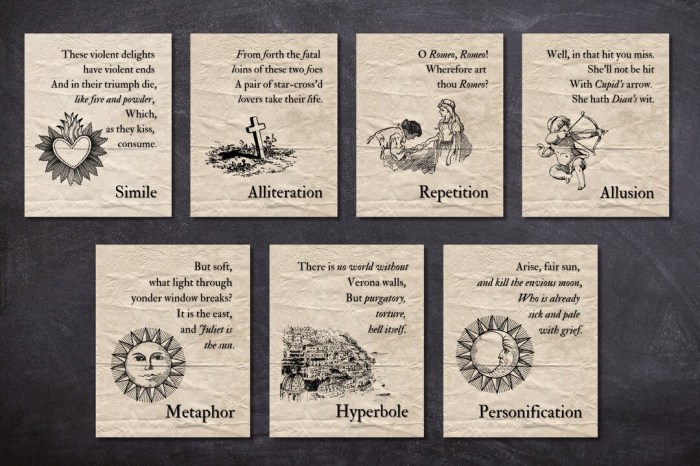
Similes play a crucial role in creating a vivid and immersive setting in Romeo and Juliet. Shakespeare uses these literary devices to paint a detailed and sensory-rich picture of the world inhabited by the characters.
Natural World
Shakespeare’s similes often draw upon the natural world to describe the characters and their surroundings. For instance, Romeo compares Juliet’s beauty to the “sun” and “stars” (2.2.3-4). These similes evoke a sense of wonder and awe, emphasizing Juliet’s extraordinary beauty and the profound impact she has on Romeo.
Architecture
Similes also provide insights into the architecture of the play’s setting. Romeo describes Juliet’s tomb as a “vasty bed” (5.3.104), suggesting its vastness and the finality of death. This simile reinforces the somber atmosphere of the scene and foreshadows the tragic events to come.
Atmosphere
Furthermore, similes contribute to the overall atmosphere of the play. For example, the Nurse describes Juliet’s grief as “a sea, a sea” (3.5.200). This simile conveys the intensity and overwhelming nature of Juliet’s sorrow, evoking a sense of drowning in despair.
Similes and Theme
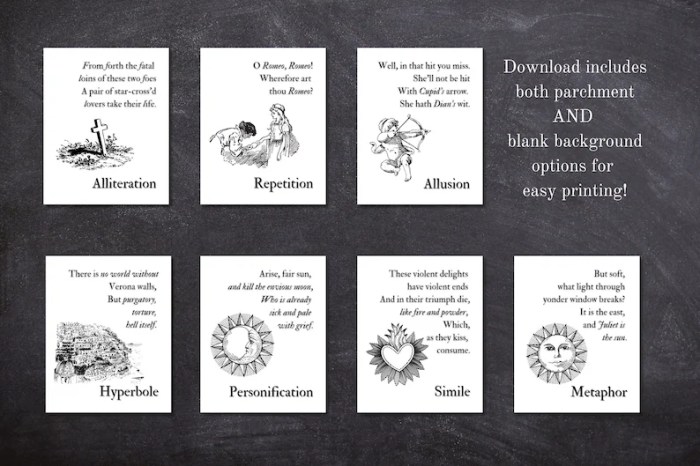
Similes play a crucial role in reinforcing the major themes of Romeo and Juliet, such as love, conflict, and fate. They provide vivid imagery that helps the audience visualize and understand these complex ideas.
Love
- Juliet’s love for Romeo is described as “as rich a jewel as a Ethiope’s ear” (Act 1, Scene 5), highlighting its rarity and preciousness.
- “My bounty is as boundless as the sea, / My love as deep” (Act 2, Scene 2), portrays Romeo’s boundless love for Juliet, which is vast and immeasurable.
Conflict
- The feud between the Montagues and Capulets is likened to “a fire that burns the heart” (Prologue), emphasizing its destructive and consuming nature.
- “Two households, both alike in dignity, / In fair Verona, where we lay our scene, / From ancient grudge break to new mutiny, / Where civil blood makes civil hands unclean” (Prologue), compares the conflict to a disease that infects and poisons the city.
Fate
- Romeo’s encounter with Juliet is described as “star-cross’d” (Prologue), suggesting that their love is doomed from the start.
- “O, I am fortune’s fool!” (Act 3, Scene 1), expresses Romeo’s belief that he is a plaything of fate, destined for tragedy.
These similes contribute to the play’s overall meaning by providing a deeper understanding of the characters’ emotions, the destructive nature of conflict, and the tragic inevitability of fate.
Just as Romeo and Juliet’s love was as “bright as the sun,” the legal battle in Parvi v. City of Kingston highlights the ongoing struggle for justice. Like the star-crossed lovers, the plaintiffs faced obstacles, but their determination shines through, reminding us that similes in Romeo and Juliet are not just literary devices but also metaphors for the human spirit’s resilience.
Similes and Language

The extensive use of similes in Romeo and Julietcontributes significantly to the play’s poetic and rhetorical qualities. Similes enhance the play’s language, adding vivid imagery, depth, and emotional resonance.
Similes and Poetic Language
Shakespeare employs similes to create vivid imagery and evoke sensory experiences. For instance, Juliet’s beauty is compared to the “fairest star of all the heaven,” while Romeo’s tears are described as “liquid pearl[s].” These similes appeal to the senses, making the play’s descriptions more tangible and evocative.
Similes and Rhetorical Devices
Similes also serve as rhetorical devices, enhancing the play’s persuasive power. For example, the comparison of Romeo’s love to “a fire” highlights its intensity and transformative nature. Such similes make the characters’ emotions and experiences more relatable and impactful.
Examples of Shakespeare’s Craftsmanship, Similes in romeo and juliet
Shakespeare’s mastery of language is evident in his use of similes. The simile “Like a dove, she tripped the ground” captures Juliet’s graceful and delicate movement. The comparison of Romeo’s heart to “a spring of love” conveys the depth and abundance of his affection.
These similes demonstrate Shakespeare’s ability to create memorable and effective imagery.
Top FAQs
What is the purpose of similes in Romeo and Juliet?
Similes serve multiple purposes in the play, including revealing character traits, creating a vivid setting, and reinforcing thematic ideas.
How do similes contribute to character development?
Similes provide insights into the characters’ personalities, emotions, and motivations by comparing them to familiar objects or experiences.
Can you provide an example of a simile that creates a vivid setting?
“The sun, for sorrow, will not show his head; / Go hence, to have more talk of these sad things; / Some shall be pardon’d, and some punished.” (Act 5, Scene 3)
